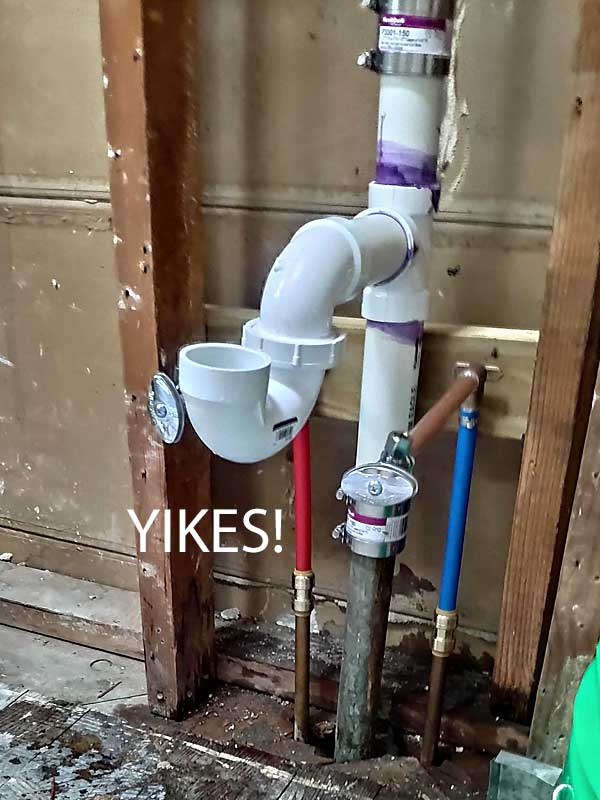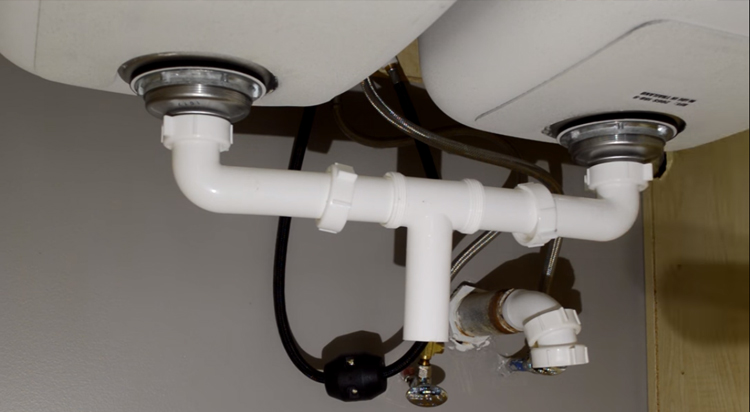How to Connect PVC Pipe to a Kitchen Sink
Connecting PVC pipe to a kitchen sink may seem like a daunting task, but with the right tools and techniques, it can be done easily. PVC pipes are a popular choice for kitchen sinks due to their durability and affordability. In this article, we will guide you through the process of connecting PVC pipe to a kitchen sink in simple steps.
How to Install PVC Pipe for a Kitchen Sink
Installing PVC pipe for a kitchen sink requires a few basic tools such as a hacksaw, PVC primer, PVC cement, and a measuring tape. Before you begin, make sure to turn off the water supply and remove any old pipes that are connected to the sink. It is also important to clean the area where the new pipes will be installed to ensure a secure connection.
Connecting PVC Pipe to a Kitchen Sink: Step-by-Step Guide
Step 1: Measure and cut the PVC pipe to the desired length using a hacksaw. Make sure to leave enough space for the fittings to be inserted at each end.
Step 2: Use sandpaper to smooth out any rough edges on the cut pipe. This will ensure a tight seal when connecting the pipes.
Step 3: Apply PVC primer to the ends of the cut pipe and the inside of the PVC fittings. This will help the PVC cement bond better.
Step 4: Apply PVC cement to the primed areas and quickly connect the pieces together, twisting them slightly to ensure a secure fit.
Step 5: Hold the pipes in place for a few seconds to allow the cement to dry and form a strong bond. Repeat this process for all the connections.
Step 6: Once all the pipes are connected, let the cement dry for at least 30 minutes before turning on the water supply.
DIY: Connecting PVC Pipe to a Kitchen Sink
If you're a DIY enthusiast, connecting PVC pipe to a kitchen sink is a project you can easily take on. The key is to have the right tools and follow the steps carefully. It is also important to properly secure the pipes to avoid any leaks or damage in the future.
Easy Ways to Connect PVC Pipe to a Kitchen Sink
Connecting PVC pipe to a kitchen sink can be done in a few easy ways. One method is to use a PVC slip joint, which allows for easy removal and replacement of the pipes if needed. Another way is to use PVC compression fittings, which do not require any special tools for installation.
Connecting PVC Pipe to a Kitchen Sink: Tips and Tricks
Here are some tips and tricks to keep in mind when connecting PVC pipe to a kitchen sink:
- Use silicone sealant around the connection points to ensure a watertight seal.
- Make sure the pipes are properly aligned before applying PVC cement to avoid any leaks.
- Use PVC primer and cement sparingly, as excessive use can lead to weak joints.
- If you're unsure about the process, it's always best to consult a professional plumber.
Step-by-Step Guide for Connecting PVC Pipe to a Kitchen Sink
To summarize, here is a step-by-step guide for connecting PVC pipe to a kitchen sink:
Step 1: Turn off the water supply and remove any old pipes connected to the sink.
Step 2: Measure and cut the PVC pipe to the desired length.
Step 3: Smooth out any rough edges on the cut pipe using sandpaper.
Step 4: Apply PVC primer to the ends of the pipe and fittings.
Step 5: Apply PVC cement to the primed areas and quickly connect the pieces together.
Step 6: Hold the pipes in place for a few seconds to allow the cement to dry.
Step 7: Let the cement dry for at least 30 minutes before turning on the water supply.
How to Properly Connect PVC Pipe to a Kitchen Sink
Properly connecting PVC pipe to a kitchen sink is essential to ensure a secure and leak-free connection. Make sure to follow the steps mentioned above and use the correct tools and techniques for a successful installation. Regular maintenance and upkeep of the pipes will also help prolong their lifespan.
The Best Methods for Connecting PVC Pipe to a Kitchen Sink
There are various methods for connecting PVC pipe to a kitchen sink, but the best one depends on your specific needs and preferences. PVC slip joints and compression fittings are easy and convenient options, while PVC cement and primer provide a strong and permanent bond. Choose the method that works best for your situation.
Expert Tips for Connecting PVC Pipe to a Kitchen Sink
To ensure a smooth and successful installation, here are some expert tips for connecting PVC pipe to a kitchen sink:
- Make sure to use the correct size pipes and fittings for your sink.
- Use Teflon tape on the threads of the connections for added protection against leaks.
- Always check for any leaks after installation and make necessary adjustments.
With these tips and techniques, you can easily connect PVC pipe to a kitchen sink and have a functional and leak-free plumbing system. Remember to follow the steps carefully and seek professional help if needed. A properly installed PVC pipe system will ensure the smooth functioning of your kitchen sink for years to come.
Why Use PVC Pipes for Your Kitchen Sink?

Benefits of PVC Pipes
 When it comes to plumbing, one of the most important components is the pipes. They are responsible for carrying water and waste in and out of your home. With the variety of materials available, it can be overwhelming to choose the right one for your kitchen sink. PVC pipes, or polyvinyl chloride pipes, have become a popular choice for many homeowners due to their numerous benefits.
Durable and Long-lasting:
PVC pipes are known for their durability and longevity. They are resistant to corrosion and can withstand high water pressure, making them a reliable choice for your kitchen sink.
Easy to Install:
PVC pipes are lightweight and easy to handle, making them simple to install. They also come in various sizes and can be easily cut to fit your specific needs, saving you time and effort during installation.
Cost-effective:
Compared to other pipe materials such as copper or steel, PVC pipes are much more affordable. This makes them a budget-friendly option for those looking to renovate their kitchen sink without breaking the bank.
Chemical and Temperature Resistant:
PVC pipes are resistant to a wide range of chemicals, making them suitable for use in the kitchen where there may be exposure to cleaning agents and other chemicals. They are also able to withstand extreme temperatures, making them ideal for hot and cold water supply.
When it comes to plumbing, one of the most important components is the pipes. They are responsible for carrying water and waste in and out of your home. With the variety of materials available, it can be overwhelming to choose the right one for your kitchen sink. PVC pipes, or polyvinyl chloride pipes, have become a popular choice for many homeowners due to their numerous benefits.
Durable and Long-lasting:
PVC pipes are known for their durability and longevity. They are resistant to corrosion and can withstand high water pressure, making them a reliable choice for your kitchen sink.
Easy to Install:
PVC pipes are lightweight and easy to handle, making them simple to install. They also come in various sizes and can be easily cut to fit your specific needs, saving you time and effort during installation.
Cost-effective:
Compared to other pipe materials such as copper or steel, PVC pipes are much more affordable. This makes them a budget-friendly option for those looking to renovate their kitchen sink without breaking the bank.
Chemical and Temperature Resistant:
PVC pipes are resistant to a wide range of chemicals, making them suitable for use in the kitchen where there may be exposure to cleaning agents and other chemicals. They are also able to withstand extreme temperatures, making them ideal for hot and cold water supply.
How to Connect PVC Pipes for Your Kitchen Sink
 Now that you know the benefits of using PVC pipes for your kitchen sink, let's dive into how to connect them. Here are the basic steps to follow:
Step 1:
Measure and cut the PVC pipes to the desired length. Make sure to use a hacksaw or PVC cutter for a clean cut.
Step 2:
Sand the edges of the pipes to remove any burrs or rough edges. This will ensure a smooth and tight fit when connecting the pipes.
Step 3:
Apply
PVC primer
to the ends of the pipes and fittings. This will help the cement adhere better and create a strong bond.
Step 4:
Next, apply
PVC cement
to the primed areas of the pipes and fittings. Be sure to work quickly as the cement dries fast.
Step 5:
Quickly insert the pipe into the fitting, making sure it is fully inserted and secure.
Step 6:
Hold the pipe and fitting together firmly for a few seconds to allow the cement to set.
Step 7:
Repeat the process for all the pipes and fittings needed to connect your kitchen sink.
Now that you know the benefits of using PVC pipes for your kitchen sink, let's dive into how to connect them. Here are the basic steps to follow:
Step 1:
Measure and cut the PVC pipes to the desired length. Make sure to use a hacksaw or PVC cutter for a clean cut.
Step 2:
Sand the edges of the pipes to remove any burrs or rough edges. This will ensure a smooth and tight fit when connecting the pipes.
Step 3:
Apply
PVC primer
to the ends of the pipes and fittings. This will help the cement adhere better and create a strong bond.
Step 4:
Next, apply
PVC cement
to the primed areas of the pipes and fittings. Be sure to work quickly as the cement dries fast.
Step 5:
Quickly insert the pipe into the fitting, making sure it is fully inserted and secure.
Step 6:
Hold the pipe and fitting together firmly for a few seconds to allow the cement to set.
Step 7:
Repeat the process for all the pipes and fittings needed to connect your kitchen sink.
Final Thoughts
 Using PVC pipes for your kitchen sink has numerous benefits, from their durability and ease of installation to their affordability and resistance to chemicals and extreme temperatures. By following these simple steps, you can easily connect PVC pipes for your kitchen sink and enjoy a reliable and long-lasting plumbing system. So, why wait? Upgrade your kitchen sink with PVC pipes today!
Using PVC pipes for your kitchen sink has numerous benefits, from their durability and ease of installation to their affordability and resistance to chemicals and extreme temperatures. By following these simple steps, you can easily connect PVC pipes for your kitchen sink and enjoy a reliable and long-lasting plumbing system. So, why wait? Upgrade your kitchen sink with PVC pipes today!












:max_bytes(150000):strip_icc()/how-to-install-a-sink-drain-2718789-hero-24e898006ed94c9593a2a268b57989a3.jpg)










































